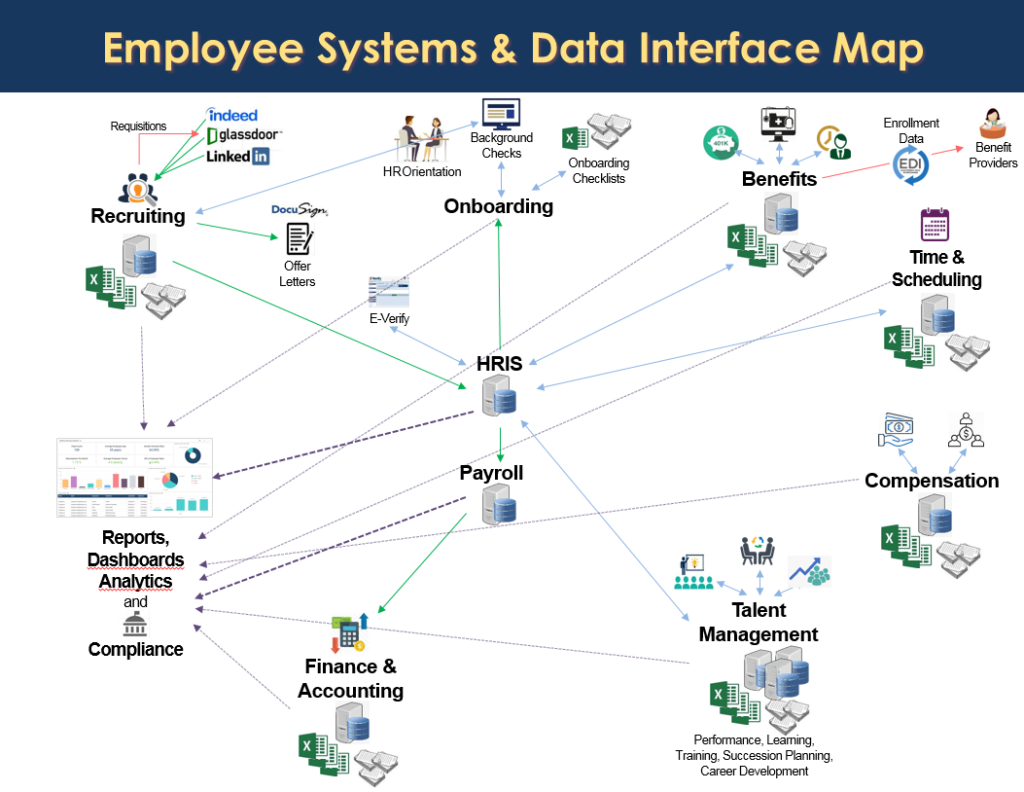You’ve spent months, potentially years, researching, evaluating and choosing the right HCM system for your organization. Your firm eventually approved the investment in this new human resource management system, and at the end of the day, you are ultimately responsible for either the success or failure of the implementation. You are eager to get a jump-start on the project, but you have been told to wait until you are formally introduced to your assigned HCM implementation consultants and the project officially kicks-off. What can you do in the meantime? How can you ensure the implementation is setup for success? How are you going to be able to successfully manage this project and do your normal HR duties? What is going to be required of you and your staff? A list of recommendations and some guidance from your HCM implementation team would be extremely helpful at this time.
Our Services team assembled the following list of recommendations to assist in preparing for a successful start to your project.
1. CAREFULLY SELECT THE RIGHT PEOPLE FOR YOUR HCM IMPLEMENTATION PROJECT TEAM
- If available, review the roles and responsibilities defined in your HCM implementation services agreement.
- Identify internal resources that are necessary to accomplish your project objectives. This may include specific domain knowledge experts, team members with a particular skill set (e.g. benefit, compensation or recruiting resources, technical team member with ability to export data from your current systems, colleagues with a solid understanding of current people management related processes, and a technical resource who is familiar with the technology infrastructure in your organization.
- Meet as a team, in advance of work beginning with your project consultants, to discuss and agree upon each team member’s project role and assigned responsibilities. Make sure these roles and responsibilities are understood and accepted by each team member. If necessary, negotiate project responsibilities and realign the team to ensure implementation success.
2. PLAN AND SET REALISTIC EXPECTATIONS
- Discuss and identify what a realistic implementation and overall project might look like with your implementation team, project sponsor(s) and executives.
- Leverage any team member’s prior experience implementing HR and/or payroll software.
- Consuming too much new technology in too short of a time period inserts additional stress and risk to any software implementation project and may decrease user adoption. Plan to discuss with your implementation consultants a realistic approach to deploying your new HCM solution in phases to diminish additional stress, mitigate risk and increase user acceptance.
- Achieving 100% user adoption of the new HCM system is unrealistic. Project expectations and outcomes should be trimmed in order to achieve and celebrate success.
3. DISCUSS PROJECT OUTCOMES
- Confirm your executive teams’ expectations related to project outcomes to avoid any misunderstandings or project disruptions.
- Define what a successful implementation looks like and make sure that everyone is on board with the vision.
- Ensure all project team members have been thoroughly briefed on desired outcomes and leadership’s expectations. Doing this at the onset of the implementation will provide clear milestones of success regardless of individual assignments or project tasks.
- Providing clarity on project outcomes and the impact of each individual role contributes to the project and will have a direct effect on the success of the project.
4. LIST AND PRIORITIZE ALL PROJECT REQUIREMENTS
- Giving team members the opportunity to list and prioritize requirements will provide a sense of ownership and individual accountability.
- Facilitating a meeting(s) related to the prioritization of requirements prior to the project kick-off will help in establishing an accurate project plan and timeline. This preparation may even accelerate the implementation planning and HCM system design stage.
- List out all the functional and technical requirements the team has for the HCM solution, the implementation and the software vendor. Then, within each of these groupings assign one of these three priority values to each requirement: “Show-Stopper/Must-Have”, “Important”, and “Nice-to-Have”.
- We have found that most requirements, if well-conceived, fall into the “important”, not the “show-stopper/must-have” priority. Categorizing a requirement as “important” means the value of this item’s outcome is significant, but there is flexibility in how the outcome is accomplished.
5. BE PREPARED FOR CHANGE
- Remember, and remind your project team, this is not your old system. This is the opportunity to embrace and facilitate change. As the project lead for your organization, change and the acceptance of change must start with you first. You are the champion and the advocate for this new people management system and ultimately for the delivering a new and more beneficial organizational experience.
- When reviewing the list of requirements or current processes, ask “Why”. Why is this required? Why is this a priority? Why do it this way?
- When you identify requirements where no one really knows the “Why”, ask the question “How”. How can this be improved?” How can this be made better or more efficient? How do we want things to look and work for all impacted parties in the future? You and your team may not be able to answer these “How” questions completely, but in the process of just asking the “How” questions, you will be preparing the team to start looking at things differently.
- It is never too soon to begin reviewing and defining the change management process with others. Discuss and agree upon the change management process within the project team and when the communication with end users or others affected by the change will begin.
- And finally, it is perfectly okay for you, your team and other members within your organization to feel a bit anxious and to be experiencing a sense of the unknown at this time. Encourage your project team to approach this HCM implementation with openness and consideration for a new and improved way of managing your people and processes. This encouragement and collective mindset will help build a bond of trust.
6. DON’T UNDERESTIMATE THE IMPORTANCE OF TRAINING
- We strongly encourage the team to allocate time for your project resources to thoroughly train and develop the skills and knowledge necessary on the journey to self-sufficiency.
- Whenever possible, request application training be face-to-face versus remote. With years of HCM implementation experience, we have found face-to-face training is far more effective and the students/trainees retain substantially more knowledge.
- Discuss how internal processes and system training documentation will be created and disseminated throughout the project and with new associates in the future. This knowledge share will be vital for current implementation success and future understanding and user adoption. For events that only happen annually, such as open enrollment and performance evaluations, this documentation can serve as an important resource and quick refresher saving time, calls into support, additional consulting fees and energy.
7. REVIEW AND CLEANSE YOUR DATA
- Important tasks you and your project team could be focusing on during this short period of time prior to the project kick-off is locating all your people related data and the systems or places this data resides. Then, identify and prioritize what specific data needs to be converted to the new system. Besides identifying what data needs to come over as part of this new HCM implementation, also discuss when the data needs to be converted.
- Consider the dilemma of converting your data “as-is” or taking the time to clean it up now. Are there codes (e.g. job, location, department, reason, etc.), code descriptions, or employee data details that need to be updated? Should any of this data be scrubbed and streamlined? Do you have data that is in mixed case, all caps or lower case that should be fixed? Putting the time and effort proactively into cleansing your data now will produce more reliable and attractive information. Scrubbing the data now will create greater data consistency and reliability. Both accuracy and appearance matter. Not only for creating, but also when presenting reports to the leadership team.
- Identifying the right resource(s) on your implementation team who will be responsible for collating, organizing, extracting and populating all people related data into the new HCM solution. Confirm their ability and skill set to perform this critically important task within the implementation. As the project is kick-offed, the implementation consultants will discuss with these resources the details of the data conversion and preferred conversion data formats, conversion process and methods.
8. ENSURE YOUR TECHNICAL READINESS
- Build a system’s interface map of the current and envisioned future state.
- Building an interface map focuses the team to think about how data flows in and out of the old system. This exercise makes your project team identify all the current system touch points, discuss the effectiveness and reliability of these touch points, and prepares your team to talk about required data interfaces and potential ways to improve or even eliminate any of them.
- If available, involve key members of your firm’s IT team to participate in the implementation. This technical involvement will help ensure the successful integration of the new HCM system with other enterprise applications (i.e. email, active directory, financials, etc.).
- A visual representation of “current” system topography and “future” state will provide the implementation consulting team with important details regarding your current systems and data flow. This visual map will also establish expectations on your future vision and help with determining the system integrations that need to be built.

9. GET ORIENTED TO THE PRODUCT EARLY
- By far one of the most critical steps to avoiding flawed design choices and ensuring the new system is better utilized, is for the project team to understand the capabilities of the new system earlier in the process to solidify sound design choices.
- However possible, get oriented to the basics of the HCM system or gather insight into the capabilities and how all functional pieces interoperate. Ask your software vendor or implementation consulting team for access to online training courses or product documentation. Gaining access to this content will serve to be valuable during the project and is something your project team can be doing during this time before the project kick-off.
10. REVIEW YOUR CURRENT SYSTEM CONTRACT(S)
- Be sure to review and understand the terms of cancellation with your existing HCM vendor(s) and whether you will need to continue some level of access after the new HCM system goes-live.
- No one wants to double pay for two subscriptions. Clearly understanding the terms and termination clause of your existing or legacy agreement will avoid surprises and unnecessary delays.
- HCM implementations are never perfect. Creating, having and knowing the details of a ‘Plan B’ to extend your legacy system subscription agreement for another month or two can allow for just the right amount of additional time to enable a successful new solution roll-out strategy. It is better to be prepared than to be panicked.
Phew! Some of the HCM implementation preparation topics listed above won’t require actual hands-on system work, but rather are simply getting everyone together to have productive collaborative sessions. Other tasks will require a significant amount of effort and coordination on your part. Any efforts put forth now will be rewarded later in the HCM implementation process and the launch of your new system.
Final comments – It’s not uncommon for your implementation consulting team to feel the excitement from you, the client, about getting the project started and launched. But unfortunately, we find the majority of clients lack the appropriate vision, blueprint or preparation required for success. We believe reviewing and having as many of these preparation tasks completed prior to the HCM implementation kick-off will significantly reduce the risk of a failed project and clearly signals to the implementation consulting team that you’re organized and ready to rock.





